
Too often news reports describe some events as “accidents” when a conventional trailer becomes unhitched while in tow. Occasionally, the mishap results in needless serious injury or death. The majority of these incidents are human error and not an unpreventable mechanical failure. This short video describes the routine that everyone towing a conventional trailer needs to perform when hitching every time.
People who tow are 10 times more likely to have a mishap and it may result in severe injury and sadly, over 500 Americans are killed each year.
(Note: This safety information does not include a weight distribution system (WDS). To learn about a WDS, click here.)

Anyone who is safety-minded will always properly secure safety chains for any trailer they tow. Using safety chains can save people from serious injury or death.
It is essential to ensure that safety chains are long enough for the trailer to achieve maximum turning angle. However, the chains should be short enough not to drag on the ground and to ensure there is enough slack in either direction of the turn. Depending on how the chains are attached to the trailer tongue, crisscrossed chains may hold the trailer tongue up off the ground if it becomes disconnected while in tow.
Chains dragging on the highway have caused many wildfires!
If the safety chains are attached to each side of the tongue, always crisscross the safety chains one time. For some states, it is the law! Also, SAE J684 states, "The safety chains shall be crossed under the trailer tongue and connected to the hitch assembly or to other towing vehicle members. NOTE—Crossing the chains under the tongue typically reduces the probability of stressing or breaking the chains when turning." Additionally, SAE J684 allows manufacturers to mount safety chains at a single center point on the tongue. In such a case, crisscrossing the chains has little value since there is no chance for one chain to be stretched tight during a turn. Click here to view each state's safety chain requirements.
A properly matched trailer coupler and hitch ball should never fail.
Never tow without the coupler locking lever secured with an approved coupler safety pin. Never use an R-Clip!
 Rather than using a coupler safety pin to secure the coupler locking lever, use a padlock to prevent tomfoolery.
Rather than using a coupler safety pin to secure the coupler locking lever, use a padlock to prevent tomfoolery.
Perform routine maintenance checks and services on the hitch assembly and trailer coupler per manufacturer specifications.
Ensure that safety chain weight ratings meet or exceed the trailer's gross vehicle weight rating (GVWR).
Each of the two required safety chains should meet or exceed the trailer’s GVWR.
If a single safety chain is used, it should run through the tongue eye and connect to the tow vehicle in the same fashion as the double chains. The single chain should meet or exceed the trailer’s GVWR.
Always replace worn or road filed safety chains before towing.
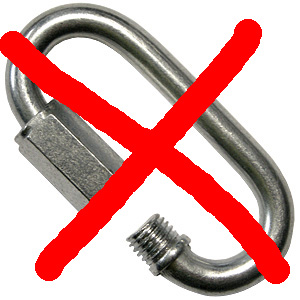 For large travel trailers, avoid using quick links to attach a safety chain to the tow vehicle. The maximum rated quick links I found only had a working load of 3,500 pounds. However, some quick links may have an additional rating beyond the working load up to 10,000 pounds.
For large travel trailers, avoid using quick links to attach a safety chain to the tow vehicle. The maximum rated quick links I found only had a working load of 3,500 pounds. However, some quick links may have an additional rating beyond the working load up to 10,000 pounds.
Replace S-Hooks with appropriately rated safety latch clevis hooks or certified S-hook with wire safety latch or snap hooks.
The only thing that should be touching the road is the vehicles' tires.
If someone stops by to chat with you while hitching a trailer, it will often distract you from the routine hookup and may cause you to skip an important safety step. Stop what you are doing. Either continue after the conversation ends or kindly ask individual(s) to cease their conversation until the hookup is complete and you have double checked the connections.
It is just as important that any of you who are not involved in the process of hitching a trailer is never to bother one who is doing so. Please restrain yourself.
Double check the hitch connection and recheck before leaving any location you stopped for a break or fuel fill-up.
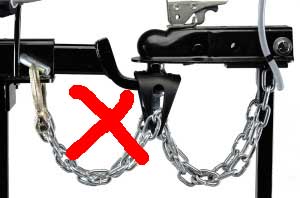 Ensure the brake and signal wiring is not damaged and it is connected and functioning correctly.
Ensure the brake and signal wiring is not damaged and it is connected and functioning correctly.
Ensure the hitch pin or lock is properly secured keeping the ball mount from coming free from the receiver.
There should rarely be a need to use a device or product to hold the chain off the ground. Utilizing safety chains the correct length will seldom touch the ground during highway towing. However, there may be some unusual trailer configurations that may need something to assist right length chains from touching the ground.
When equipped, always attach the breakaway cable to the tow vehicle. The breakaway cable should not be longer than to allow the trailer to turn and not much longer than the extended length of the safety chains. It is vital for the trailer emergency brakes are activated within milliseconds if the trailer becomes disconnected and the chains fail. Never wrap the breakaway cable around or run through the safety chain, nor attach it to the chain hook. It is always good to verify the proper slack and test the breakaway switch at least once a year.
"Good to know. When I picked up my new trailer, the man doing the walk thru ran the emergency cable thru the safety chain." Chip Thomas, RV buyer.
Periodic greasing of the hitch ball and coupler will prolong the life of these components.
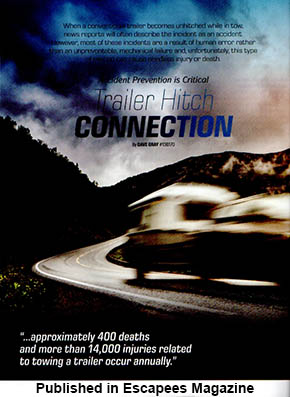 Don't be Misinformed
Don't be MisinformedSome dealers, salespersons, and hitch installers are not appropriately trained. Trailers with a chain attached on each side of the tongue, the SAE J684, paragraph 7.5.2 states: "Safety chain shall be connected to the towing vehicle and trailer so that the slack for each length of chain is approximately the same when the vehicles are aligned on a common front to rear centerline. There shall be no more slack than necessary to permit proper turning of the vehicles. The safety chains shall be crossed under the trailer tongue and connected to the hitch assembly or to other towing vehicle members."
In some States, it is the law to use and cross the safety chains.
Ensure that the lowest weight rating within the three components shown below meets or exceed the trailer’s gross vehicle weight rating (GVWR). The lowest weight rating between these components and the tow vehicle's conventional TWR becomes the maximum allowed TWR.
Example: The lowest rating within the hitch components is the hitch ball rated at 10,000 pounds, and the tow vehicle's published TWR is 14,000 pounds. The lower rating of the hitch ball becomes the maximum towing capacity or maximum allowed TWR.
However, one could learn that after using the RV Tow Check App, the maximum RVTC, due to the weight of the tow vehicle, is only 9,820 pounds. The RVTC of 9,820 pounds is the maximum trailer weight that this vehicle should tow regardless of higher ratings of the hitch assembly or the tow vehicle's published TWR.
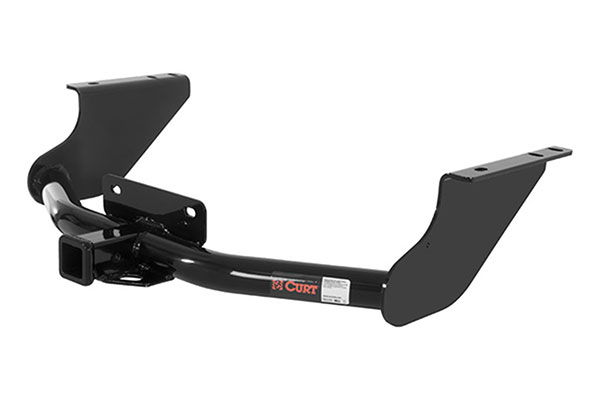
Example:
14,000 lbs.
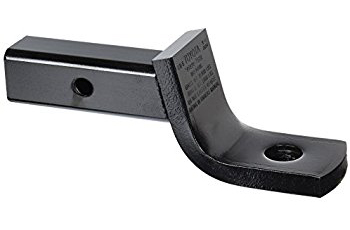
Example:
12,000 lbs.
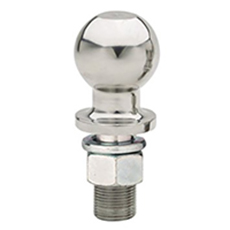
Example: 10,000 lbs.
Note: The above components may have an additional higher rating when used with a weight distribution system. However, always follow the max towing capacity rating rule between the hitch assembly, TWR and RVTC.
Last updated on June 29, 2021
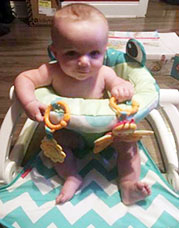 The morning after Memorial Day 2017, I became aware of a horrific tragedy in Lincoln County, Kentucky. It was caused by a travel trailer that unhitched from a truck. The trailer then moved into the opposite lane and met head-on into an SUV. The SUV driver was killed, and six-month-old Colt Tuff Shaffer was severely injured. By Thursday morning I learned that Colt was not going to make it and later that day Colt succumbed to his injuries.
The morning after Memorial Day 2017, I became aware of a horrific tragedy in Lincoln County, Kentucky. It was caused by a travel trailer that unhitched from a truck. The trailer then moved into the opposite lane and met head-on into an SUV. The SUV driver was killed, and six-month-old Colt Tuff Shaffer was severely injured. By Thursday morning I learned that Colt was not going to make it and later that day Colt succumbed to his injuries.
I cannot ever relate to what the family has endured during this time. However, this tragedy hit me with much sorrow, sadness, and anger. Out of my anger, I created this new page on Wednesday, May 31.
I dedicate this page to Colt’s memory. I ask all who read this page share it with anyone who is learning about towing a conventional trailer or needs a reminder. Education and applying what is learned is the key to preventing injuries and death.
First news report
One killed, three injured after bad crash in Lincoln County
Second news report
Family donating organs of six-month-old: "My baby is going to be a superhero"
You can help
GoFundMe for Colt
TWR = Trailer Weight Rating
RVTC = Realistic Vehicle Towing Capacity (Provided by the RV Tow Check App)
GVWR = Gross Vehicle Weight Rating